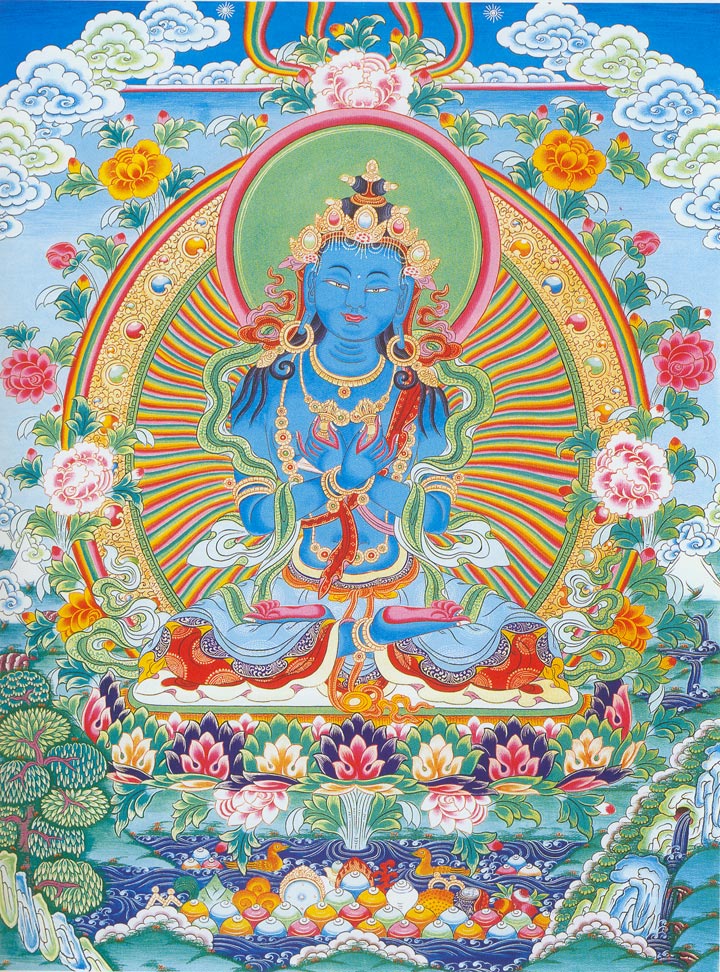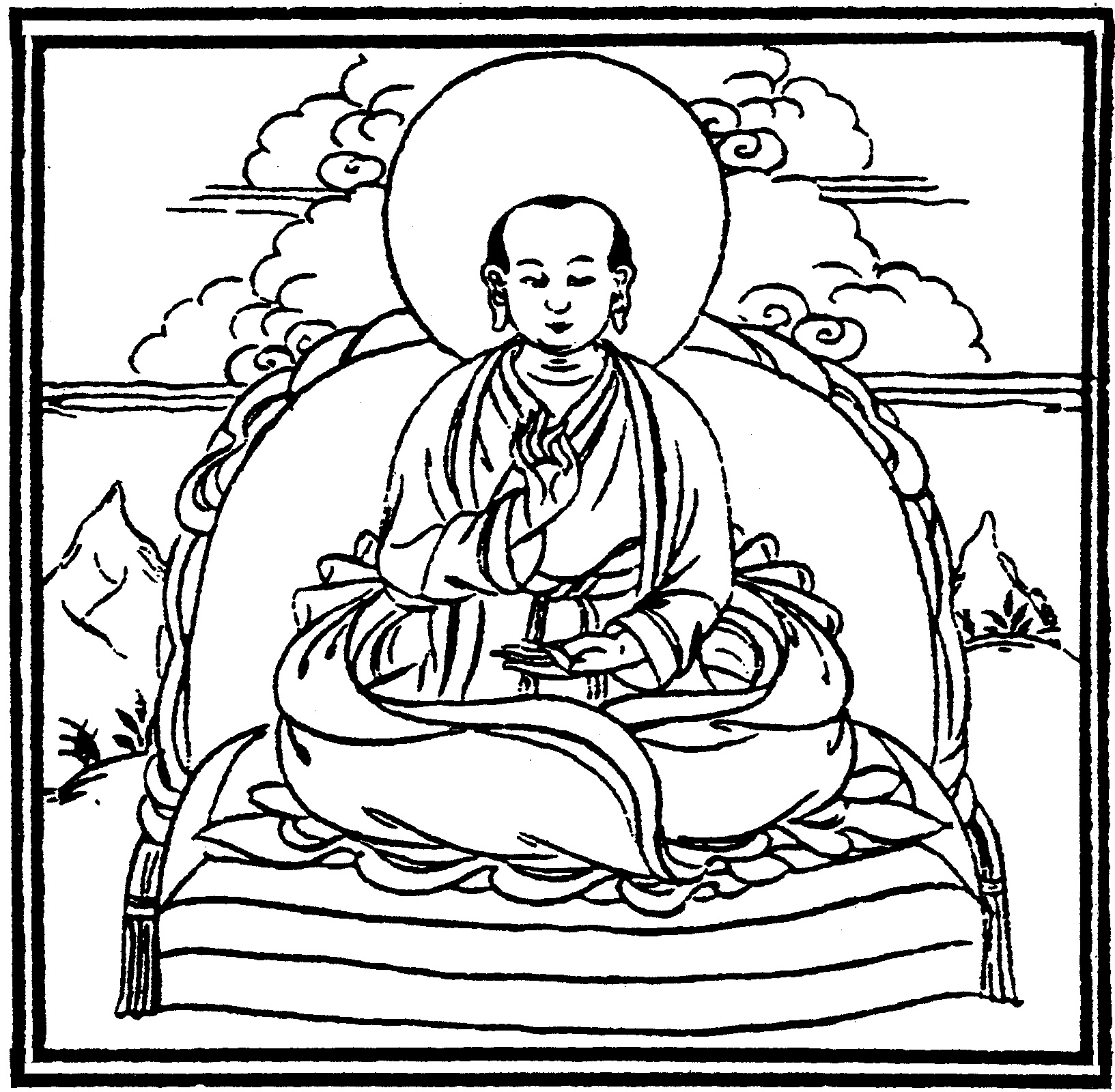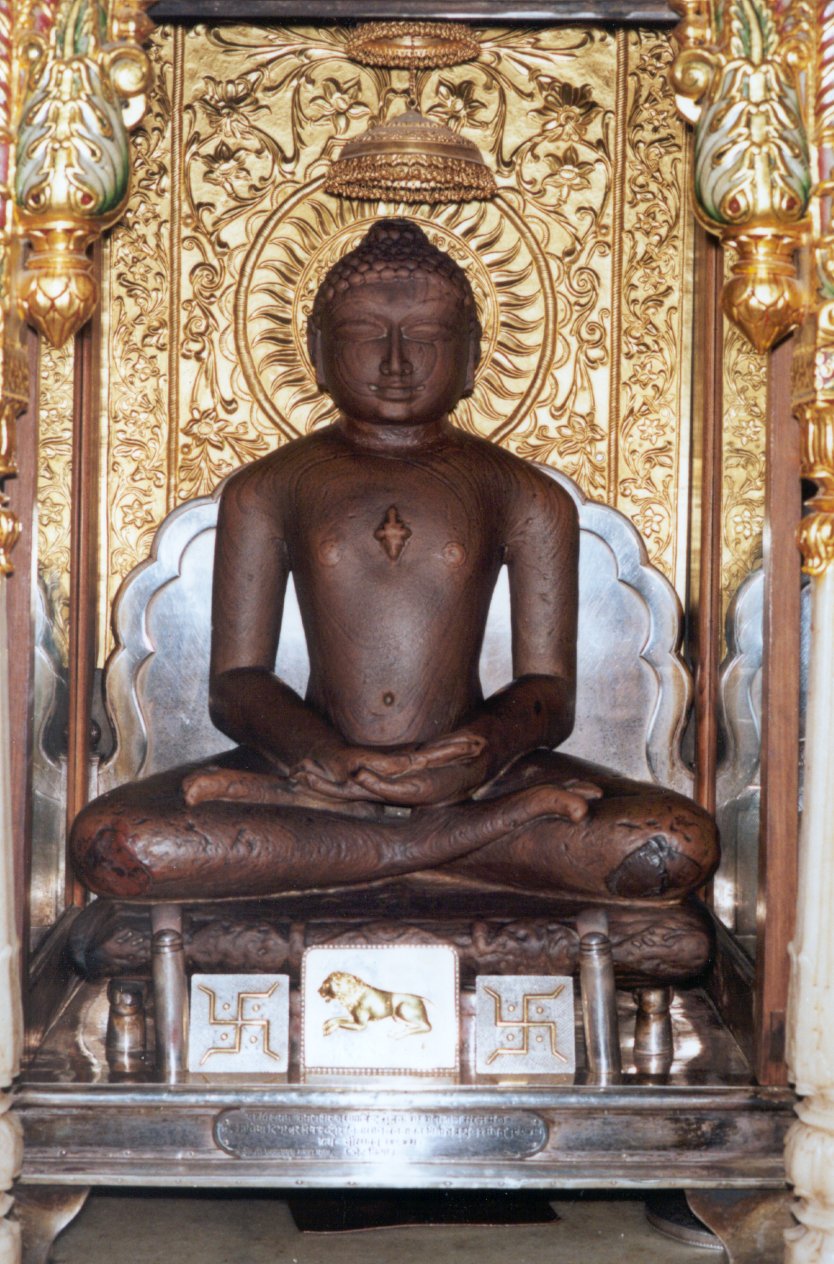|
Samantabhadri (tutelary)
Samantabhadri (Sanskrit; Devanagari: समन्तभद्री ; IAST: samantabhadrī, ) is a dakini and female Buddha from the Vajrayana Buddhist tradition. She is the consort and female counterpart of Samantabhadra, known amongst some Tibetan Buddhists as the Primordial Buddha. Samantabhadri herself is known as the primordial Mother Buddha. Samantabhadri is the dharmakaya dakini aspect of the Trikaya, or three bodies of a Buddha. As such, Samantabhadri represents the aspect of Buddhahood in whom delusion and conceptual thought have never arisen. As font or wellspring of the aspects of the divine feminine she may be understood as the Great Mother or as an aspect of Prajnaparamita. Samantabhadri is a figure found primarily in the Nyingma or Old Translation school of Tibetan Buddhism. A figure that is nearly equivalent to Samantabhadri in the New Translation or Sarma schools is Vajradhatu-ishvari; she is dark blue and her consort is Vajradhara. Description and meaning Sama ... [...More Info...] [...Related Items...] OR: [Wikipedia] [Google] [Baidu] |
Adi-Buddha Samantabhadra
The Ādi-Buddha (, Ch: 本佛, Jp: honbutsu, First Buddha, Original Buddha, or Primordial Buddha) is a Mahayana Buddhist concept referring to the most fundamental, supreme, or ancient Buddha in the cosmos. Another common term for this figure is Dharmakāya Buddha. The term emerges in tantric Buddhist literature, most prominently in the Kalachakra. "Ādi" means "first", such that the Ādibuddha was the first to attain Buddhahood. "Ādi" can also mean "primordial", not referring to a person but to an innate wisdom that is present in all sentient beings. In East Asian Buddhism, the term 本佛 (běn fó, original Buddha, root Buddha) also appears in the works of Tiantai and Tendai school, referring to the original Buddha of the ''Lotus Sutra'' which was also later identified with the cosmic Buddha Mahavairocana. It and similar terms were also used in the traditions of Chinese Esoteric Buddhism and Shingon to refer to the cosmic Buddha Mahavairocana. Indian sources According ... [...More Info...] [...Related Items...] OR: [Wikipedia] [Google] [Baidu] |
Gender
Gender is the range of social, psychological, cultural, and behavioral aspects of being a man (or boy), woman (or girl), or third gender. Although gender often corresponds to sex, a transgender person may identify with a gender other than their sex assigned at birth. Most cultures use a gender binary, in which gender is divided into two categories, and people are considered part of one or the other;Kevin L. Nadal, ''The Sage Encyclopedia of Psychology and Gender'' (2017, ), p. 401: "Most cultures currently construct their societies based on the understanding of gender binary—the two gender categorizations (male and female). Such societies divide their population based on biological sex assigned to individuals at birth to begin the process of gender socialization." those who are outside these groups may fall under the umbrella term '' non-binary''. Some societies have ''third genders'' (and ''fourth genders'', etc.) such as the hijras of South Asia and two-spirit per ... [...More Info...] [...Related Items...] OR: [Wikipedia] [Google] [Baidu] |
Dakinis
A ḍākinī (; ; ; ; alternatively 荼枳尼, ; 荼吉尼, ; or 吒枳尼, ; Japanese: 荼枳尼 / 吒枳尼 / 荼吉尼, ''dakini'') is a type of goddess in Hinduism and Buddhism. The concept of the ḍākinī somewhat differs depending on the context and the tradition. For example, in earlier Hindu texts and East Asian esoteric Buddhism, the term denotes a race of demonesses who ate the flesh and/or vital essence of humans. In Hindu Tantric literature, Ḍākinī is the name of a goddess often associated with one of the six chakras or the seven fundamental elements ('' dhātu'') of the human body. In Nepalese and Tibetan Buddhism, meanwhile, 'ḍākinī' (also wisdom ḍākinī) can refer to both what can be best described as fierce-looking female embodiments of enlightened energy, and to human women with a certain amount of spiritual development, both of whom can help Tantric initiates in attaining enlightenment. In Japan, the ḍākinīs – held in the East Asian Bud ... [...More Info...] [...Related Items...] OR: [Wikipedia] [Google] [Baidu] |
Buddhas
In Buddhism, Buddha (, which in classic Indic languages means "awakened one") is a title for those who are spiritually awake or enlightened, and have thus attained the supreme goal of Buddhism, variously described as awakening or enlightenment (''bodhi''), '' Nirvāṇa'' ("blowing out"), and liberation (''vimokṣa''). A Buddha is also someone who fully understands the '' Dhārma'', the true nature of all things or phenomena ('' dhārmata''), the ultimate truth. Buddhahood (Sanskrit: ''buddhatva''; or ; zh, c=成佛) is the condition and state of being a Buddha. This highest spiritual state of being is also termed ''sammā-sambodhi'' (Sanskrit: ''samyaksaṃbodhi''; "full, complete awakening") and is interpreted in many different ways across schools of Buddhism. The title of "Buddha" is most commonly used for Gautama Buddha, the historical founder of Buddhism, who is often simply known as "the Buddha". The title is also used for other sentient beings who have achiev ... [...More Info...] [...Related Items...] OR: [Wikipedia] [Google] [Baidu] |
Seventeen Tantras
The ''Seventeen Tantras of the Esoteric Instruction Series'' () or the ''Seventeen Tantras of the Ancients'' (''rnying-ma'i rgyud bcu-bdun'') are an important collection of tantras in the Nyingma school of Tibetan Buddhism. They comprise the core scriptures of the "esoteric instruction series" ('' Menngagde'') of Dzogchen teachings and are its most authoritative scriptures. The Seventeen Tantras are part of the '' Vima Nyingthig'' (''"Inner Essence of Vimalamitra"''), a terma cycle of Dzogchen texts revealed by the treasure discoverer Zhangton Tashi Dorje (c. 1097-1127) and associated with the 8th century Indian monk Vimalamitra who is traditionally believed by the Nyingma school to have first brought these texts to Tibet. The ''Vima Nyingthig'' itself consists of ' tantras' (''rgyud''), 'agamas' (''lung''), and ' upadeshas' (''man ngag''). The other texts are mainly exegetical literature on the material found in the Seventeen tantras. The Seventeen Tantras explain the vie ... [...More Info...] [...Related Items...] OR: [Wikipedia] [Google] [Baidu] |
Yeshe Tsogyal
Yeshe Tsogyal (c. 757 or 777 – 817 CE), also known as "Victorious Ocean of Knowledge", "Knowledge Lake Empress" (, ཡེ་ཤེས་མཚོ་རྒྱལ), or by her Sanskrit name ''Jñānasāgarā'' "Knowledge Ocean", or by her clan name "Lady Kharchen", attained enlightenment in her lifetime and is considered the Mother of Tibetan Buddhism. Yeshe Tsogyal is the highest woman in the Nyingma Vajrayana lineage. Some sources say she, as Princess of Karchen, was either a wife or consort of Tri Songdetsen, emperor of Tibet, when she began studying Buddhism with Padmasambhava, who became her main karmamudrā consort. Padmasambhava is a founder-figure of the Nyingma tradition of Tibetan Buddhism, and is considered as a second buddha of our era. She is known to have revealed terma with Padmasambhava and was also the main scribe for these terma. Later, Yeshe Tsogyal also hid many of Padmasambhava's terma on her own, under the instructions of Padmasambhava for future generation ... [...More Info...] [...Related Items...] OR: [Wikipedia] [Google] [Baidu] |
Mahamudra
Mahāmudrā (Sanskrit: महामुद्रा, , contraction of ) literally means "great seal" or "great imprint" and refers to the fact that "all phenomena inevitably are stamped by the fact of wisdom and emptiness inseparable". Mahāmudrā is a multivalent term of great importance in later Indian Buddhism and Tibetan Buddhism which "also occurs occasionally in Hindu and East Asian Buddhist esotericism." The name also refers to a body of teachings representing the culmination of all the practices of the New Translation schools of Tibetan Buddhism, who believe it to be the quintessential message of all of their sacred texts. The practice of Mahāmudrā is also known as the teaching called " Sahajayoga" or "Co-emergence Yoga". In Tibetan Buddhism, particularly the Kagyu school, Sahaja Mahāmudrā is sometimes seen as a different Buddhist vehicle ( yana), the "Sahajayana" (Tibetan: ''lhen chig kye pa''), also known as the vehicle of self-liberation. Jamgon Kongtrul, a T ... [...More Info...] [...Related Items...] OR: [Wikipedia] [Google] [Baidu] |
Lotus Posture
Lotus position or Padmasana () is a cross-legged sitting meditation pose from ancient India, in which each foot is placed on the opposite thigh. It is an ancient asana in yoga, predating hatha yoga, and is widely used for meditation in Hindu, Tantra, Jain, and Buddhist traditions. Variations include easy pose (Sukhasana), half lotus, bound lotus, and psychic union pose. Advanced variations of several other asanas including yoga headstand have the legs in lotus or half lotus. The pose can be uncomfortable for people not used to sitting on the floor, and attempts to force the legs into position can injure the knees. Shiva, the meditating ascetic God of Hinduism, Gautama Buddha, the founder of Buddhism, and the Tirthankaras in Jainism have been depicted in the lotus position, especially in statues. The pose is emblematic both of Buddhist meditation and of yoga, and as such has found a place in Western culture as a symbol of healthy living and well-being. Etymology and histo ... [...More Info...] [...Related Items...] OR: [Wikipedia] [Google] [Baidu] |
Digambara
''Digambara'' (; "sky-clad") is one of the two major Jain schools and branches, schools of Jainism, the other being ''Śvetāmbara'' (white-clad). The Sanskrit word ''Digambara'' means "sky-clad", referring to their traditional monastic practice of neither possessing nor wearing any clothes. Nakedness was the ideal practice of lord Mahavira and his immediate followers. Mahavira emphasized the importance of nakedness for monks. It symbolizes complete detachment and is an ideal form of conduct. Mahavira believed that renouncing clothes made the body immune to external influences like heat and cold, increasing resilience. Without clothes, a monk would avoid the distractions of acquiring, maintaining, and washing garments, allowing him to focus on spiritual growth and self-discipline. Digambara and Śvetāmbara traditions have had historical differences ranging from their dress code, their temples and iconography, attitude towards female monastics, their legends, and the texts the ... [...More Info...] [...Related Items...] OR: [Wikipedia] [Google] [Baidu] |
Iconography
Iconography, as a branch of art history, studies the identification, description and interpretation of the content of images: the subjects depicted, the particular compositions and details used to do so, and other elements that are distinct from artistic style. The word ''iconography'' comes from the Ancient Greek, Greek ("image") and ("to write" or ''to draw''). A secondary meaning (based on a non-standard translation of the Greek and Russian equivalent terms) is the production or study of the religious images, called "Icon, icons", in the Byzantine art, Byzantine and Eastern Orthodox Churches, Orthodox Christian tradition. This usage is mostly found in works translated from languages such as Greek or Russian, with the correct term being "icon painting". In art history, "an iconography" may also mean a particular depiction of a subject in terms of the content of the image, such as the number of figures used, their placing and gestures. The term is also used in many academic ... [...More Info...] [...Related Items...] OR: [Wikipedia] [Google] [Baidu] |







